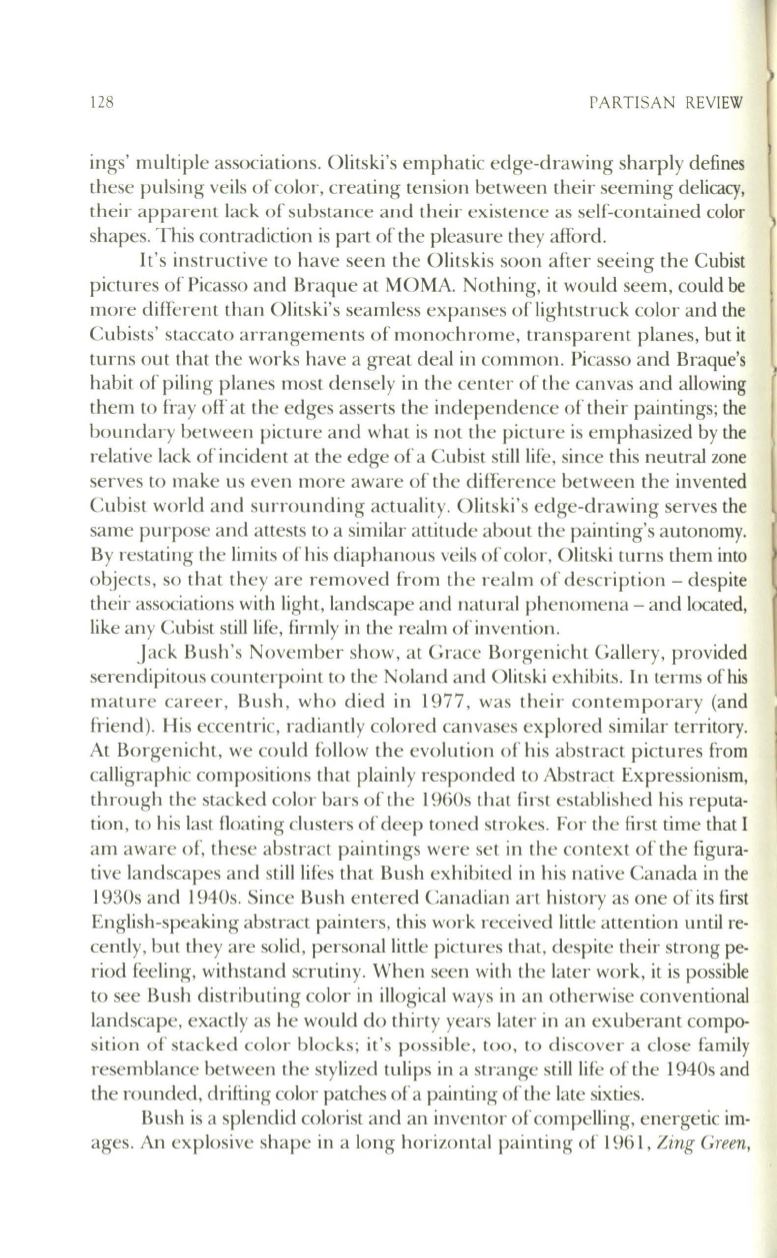
128
PARTISAN REVIEW
ings' multiple associations. Olitski's emphatic edge-drawing sharply defines
these pulsing veils of color, creating tension between their seeming delicacy,
their appal-ent lack of substance and their existence as self-contained color
shapes. This contradiction is part of the pleasure they afford.
It's instructive to have seen the Olitskis soon after seeing the Cubist
pictures of Picasso and Brague at MOMA. Nothing, it would seem, could
be
more different than Olitski's seamless expanses of lightstruck color and the
Cubists' staccato arrangements of monochrome, transparent planes, but it
turns out that the works have a great deal in common. Picasso and Brague's
habit of piling planes most densely in the center of the canvas and allowing
them to fray off at the edges asserts the independence of their paintings; the
boundary between picture and what is not the picture is emphasized by the
relative lack of incident at the edge of a Cubist still life, since this neutral zone
serves to make us even more aware of the difference between the invented
Cubist world and surrounding actuality. Olitski's edge-drawing serves the
same purpose and attests to a similar attitude about the painting's autonomy.
By restating the limits of his diaphanous veils ofcolor, Olitski turns them into
objects, so that they are removed from the realm of description - despite
their associations with light, landscape and natural phenomena - and located,
like any Cubist still life, firmly in the realm of invention.
Jack Bush's November show, at Grace Borgenicht Gallery, provided
serendipitous counterpoint to the Noland and Olitski exhibits. In terms of his
mature career, Bush, who died in 1977, was their contemporary (and
friend). His eccentric, radiantly colored canvases explored similar territory.
At Borgenicht, we could follow the evolution of his abstract pictures from
calligraphic compositions that plainly responded to Abstract Expressionism,
through the stacked color bars of the I960s that first established his reputa–
tion, to his last floating clusters of deep toned strokes. For the first time that I
am aware of, these abstract paintings were set in the context of the figura–
tive landscapes and stilllifes that Bush exhibited in his native Canada in the
I930s and 1940s. Since Bush entered Canadian art history as one of its first
English-speaking abstract painters, this work received little attention until re–
cently, but they are solid, personal little pictures that, despite their strong pe–
riod feeling, withstand scrutiny. When seen with the later work, it is possible
to see Bush distributing color in illogical ways in an otherwise conventional
landscape, exactly as he would do thirty years later in an exuberant compo–
sition of stacked color blocks; it's possible, too , to discover a close family
resemblance between the stylized tulips in a strange still life of the 1940s and
the rounded, drifting color patches of a painting of the late sixties.
Bush is a splendid colorist and an inventor of compelling, energetic im–
ages.
An
explosive shape in a long horizontal painting of 1961,
Zing Green,


